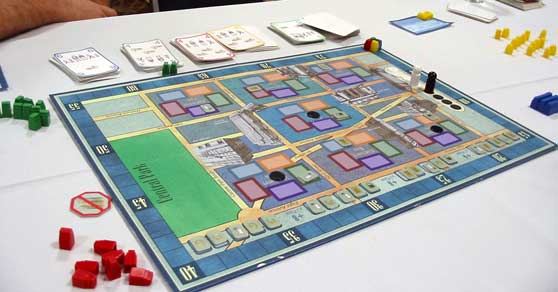I'm having trouble with Fifth Avenue. I can't decide what to make of this game. Let me talk you through it and see what you think. First off, the production is well up to alea's usual standards, with some good artwork. Fifth Avenue uses a lot of cards, which are printed on good, sturdy stock. The rules are straightforward and easy to follow. The plot of Fifth Avenue is about property development – in New York, as it happens. The board shows a section of the city's grid of streets and the blocks of buildings between. Players build businesses and skyscrapers on the blocks. Your skyscrapers score points according to how many different businesses are next to them. So there are two important things you have to do: get your skyscrapers on the board (you start with a few) and put businesses alongside them. Building skyscrapers is a complicated business. Especially in this game. To start with, there are two Commissioners (pawns), who march across the board from City Hall to Central Park. Everybody moves a Commissioner at the end of their turn, but there are other opportunities to move one. When a Commissioner completes his walk, auctions are held in the city blocks he's visited and then in Central Park. (Central Park is an additional scoring opportunity at the end of the game, rather than an opportunity to concrete over the park.) 
The auction is rather clever. Players bid using the cards in their hand. They choose one colour and can then only bid using this colour – plus Black cards, which are wild. Only the winner pays out, which encourages players to contest each auction. The winner adds a skyscraper or two to one of the plots in the city block. There are some clever touches here: the higher the cards you bid, the fewer skyscrapers you erect. The plots are colour-coded to match the cards, so the plot you use will depend on the colour you bid with. Players are not just competing to build, but are fighting over where to build. The implication of this is that the cards in your hand can limit your options. To put it another way: play to your strengths. And plan ahead. By comparison, getting businesses on the board is straightforward. You pick one up and place it in a plot (that doesn't have skyscrapers in it). And thereby hangs a tail. There aren't very many businesses available, so there's a good reason to grab them before anyone else. So people tend to seize businesses and put them down next to their existing skyscrapers. A player can place a business each turn and always moves a Commissioner. But auctions don't happen until a Commissioner has moved five times. So, by the time any auctions happen, nine businesses may already be on the board. Out of a total of twelve. And the game finishes once the last business has been played. The result is a game that ends abruptly with low scores. I'm told that this is not how it's supposed to work. That players should be fighting to build their skyscrapers to score more points. But the skyscrapers are worthless without businesses next to them – and you can't rely on your opponents to put businesses where you'll score. Nobody I've played with has been able to resist the urge to grab businesses. And once one person is doing it, you can't afford to be left behind. My suspicion is that Fifth Avenue has got a bit over-complicated. Yes, building skyscrapers will score you points. But you have to wait several turns to get the opportunity and then you have to win the bidding war with other players who want to do something different. By contrast, placing a business next to one of your skyscrapers is something you just do. And it produces an immediate improvement in your position. You actually have three actions in your turn, with later actions constrained by what you do to start with. For example, if you want to pick up a black (wild) card, then you also have to move a Commissioner – as well as moving a Commissioner at the end of your turn. This is quite a good option if you want to win auctions and get skyscrapers on the board. On the other hand, if you place a business as your first action, you can only pick up coloured cards. I find this reinforces the way you're playing. If you place businesses then you won't have lots of black cards and won't want many auctions. If you have black cards, you move a Commissioner more often and trigger more auctions. I await further enlightenment on this game, but, at the moment, I think alea has produced its first dud.
Fifth Avenue was designed by Wilko Manz and published (in German) by alea and (in English) Rio Grande Games. It is a strategy board game for 2-4 players and takes about an hour to play. It is readily available in specialist games shops in the UK at around Ł28.
Page created 8th November 2004. Last modified 24th June 2005. This website produced by Paul Evans. © Copyright Paul Evans 2004-2005. All trademarks acknowledged. Problems, comments and feedback to the Webmaster. |
Pevans |